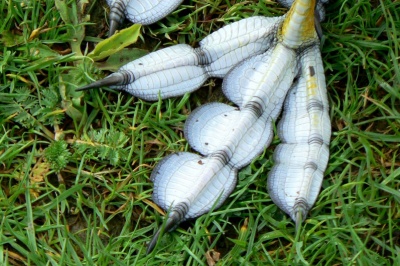
- Fulica atra
Identification
The Common Coot is very dark grey with a black head and neck, a white forehead and beak and red eyes. The feet are large and lobed. Newly hatched young are mostly black and have a typical red head. Older juveniles and immatures have pale breast and throat and are mostly light grey to grey-brown on the rest of the plumage. At these ages, the bill is yellowish.
Distribution
Western Palearctic: a common and widespread bird breeding from the British Isles and Iberia east to Russia and from southern parts of Norway, Sweden and Finland, south to the Mediterranean. Also breeds on the Balearic Islands, Corsica and Sardinia, Sicily and Cyprus. A very local breeder in northwestern Africa and the Nile Delta, in Turkey and the Middle East, has bred in the Canary Islands. Populations in the north and east are migratory, the remainder are resident, dispersive or partially migratory. More widespread in southern parts of the region in winter. Regular winter visitor to the Azore Islands (has bred) and the Canary Islands.
Asia and Australasia: Found in much of the region with northern populations being migratory.
Vagrancy
Vagrant north to Svalbard, Iceland (has bred) and the Faroe Islands.
Taxonomy
Subspecies1
- F. a. atra - Palearctic; winters to Africa, Indonesia and Philippines
- F. a. lugubris - Mountains of Java and northwest New Guinea
- F. a. novaeguinea - Mountains of central New Guinea (some sources does not recognize this subspecies, instead including these birds in F. a. lugubris2)
- F. a. australis - Wetlands of Australia, Tasmania, New Zealand and Buru Island.
Habitat
Breeds on lakes and large ponds, frequently on reservoirs, gravel-pits and ponds in urban parks and also slow-flowing rivers. In winter often moves to larger; more open waterbodies, estuaries and on occasion, the sea. Not shy and frequently feeds in fields.
Behaviour
After breeding, this species has a period where moult makes the birds unable to fly3.
Vocalisation
<flashmp3>Fulica atra (song).mp3</flashmp3>
Listen in an external program
References
- Clements James F. 2007. The Clements Checklist of Birds of the World. 6th ed., with updates to October 2008. Ithaca: Cornell University Press. ISBN 9780801445019
- Avibase entry read December 2008
- Birdlife International factsheet read December 2008
External Links





